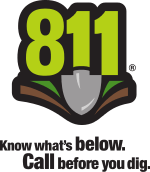8-1-1
8-1-1 is an N-1-1 telephone number in Canada and the United States. In Canada, the number is used for non-urgent health services. In the United States, 8-1-1 provides a uniform national phone number to access local utility location services.
United States

In March of 2005, the United States Federal Communications Commission (FCC) made 8-1-1 the universal number for the 71 regional services that coordinate location services for underground public utilities in the U.S.[1] Before that time, each of these "call before you dig" services[2] had its own 800 number, and the FCC and others wanted to make it as easy as possible for everyone planning an excavation to call first.
This safety measure not only helps prevents damage that interrupts telecommunications, but also the cutting of subterranean power lines, water mains, and natural gas pipes. Underground utilities are located via color-coded markings typically up to and not past the user's service connection or meter. Lines on the other side of the meter or service connection are considered to be part of the customer's property and will typically not be located by these services. Establishment of an abbreviated dialing number for this purpose was required by the Pipeline Safety Improvement Act[3] of 2002.
The use of 8-1-1 for "call before you dig" services was long established in California and Nevada, through an organization known as Underground Service Alert, before the FCC mandated its use for this purpose.
Previous use
Prior to 2005, the FCC had never officially assigned 8-1-1 for any service, but did not prevent its use either. Traditionally, 8-1-1 has been a direct line to the business office of the telephone company providing service on the line. From there, one may perform some or all of the following operations:
- Pay the bill
- Order additional lines
- Order and cancel services
- Order and rent equipment
- Order calling cards
- Speak to customer service
Such services have been merged into 6-1-1. Mobile phones sometimes use 6-1-1 for this purpose as well. Many telephone companies, including Canada's Telus, are experimenting with merging 8-1-1 and 6-1-1 service now that neither will usually route directly to a human operator. Generally, an automatic phone answering system or other automated attendant will now answer both lines anyway.
At one point in time, this number routed to 9-1-1 as a misdialed call, but this operation has long passed from use. It was designed so that when someone was in a crisis, they would not be panicked by having reached the wrong line. However, the reassignment of this code was required due to the scarcity of N11 numbers.
Canada
In Canada, in July 2005, the Canadian Radio-television and Telecommunications Commission (CRTC) assigned 8-1-1 for non-urgent health teletriage/telehealth services. In May 2008, the province of Quebec announced the adoption of 8-1-1 for this purpose,[4] followed by British Columbia in November 2008,[5] Nova Scotia in July 2009,[6] Saskatchewan in March 2013,[7] Alberta in June 2015,[8] and Newfoundland and Labrador in July 2015.[9] Since 1997 New Brunswick implemented a province-wide Tele-Care service, adopting the 8-1-1 number in place of the toll-free 800 number in 2010.[10][11]
References
- ↑ http://hraunfoss.fcc.gov/edocs_public/attachmatch/DOC-257293A1.pdf
- ↑ "3-Digit Numbers Used in New York City". 411newyork.org. 2010-03-27. Archived from the original on 15 August 2010. Retrieved 2010-08-27.
- ↑ "Text of H.R. 3609 (107th): Pipeline Safety Improvement Act of 2002 (Passed Congress/Enrolled Bill version) - GovTrack.us". GovTrack.us.
- ↑ "LE MINISTRE PHILIPPE COUILLARD ANNONCE QUE LE SERVICE INFO-SANTÉ EST ACCESSIBLE PARTOUT EN COMPOSANT LE 8-1-1". Archived from the original on June 7, 2008.
- ↑ "CBC News - British Columbia - 811 hotline offers non-emergency health advice". Cbc.ca. 2008-11-21. Retrieved 2010-08-19.
- ↑ "Nova Scotia Launches HealthLink 811 | News Releases | Government of Nova Scotia". Gov.ns.ca. 2009-07-29. Retrieved 2010-08-19.
- ↑ "Saskatchewan's HealthLine Number Changing to 811". Government of Saskatchewan. 2013-03-05. Retrieved 2013-04-01.
- ↑ "Accessing health advice now as easy as 8-1-1". Government of Alberta. 2015-06-01. Retrieved 2015-06-01.
- ↑ "Provincial Government Launches Enhancements to HealthLine". Government of Newfoundland and Labrador. 2015-07-02. Retrieved 2015-12-12.
- ↑ "Tele-Care Frequently Asked Questions". Government of New Brunswick. Retrieved 2016-01-16.
- ↑ "New Brunswick 811 Tele-Care Service". 2010-04-01. Retrieved 2016-01-16.
External links
- Call811.com
- CRTC Approval of 8-1-1 in Canada
- 811 Hotline Offers Non-emergency Health Advice
- Nova Scotia HealthLink